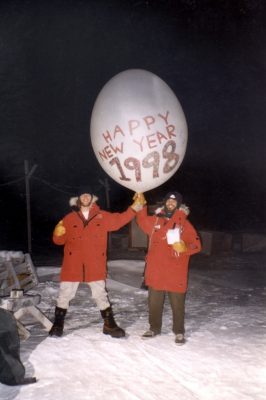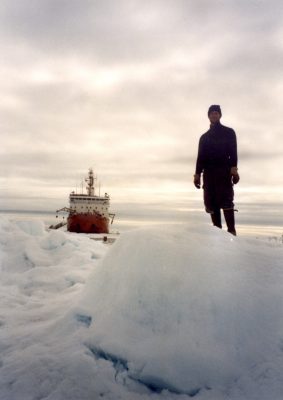
Buoyed by a sense of adventure and a passion for clouds, a scientist enters his third decade investigating Earth’s fragile cold regions.
Officially, the U.S. Department of Energy’s (DOE) Atmospheric System Research (ASR) program dates back to 2010. But because of funding cycles already underway back then through administrative predecessors, ASR has an archive of research projects going back to Fiscal Year (FY) 2006.
One of the oldest projects, funded in FY 2007 by the DOE’s Atmospheric Radiation Measurement (ARM) user facility to investigate mixed-phase clouds, featured a principal investigator (PI) named Matthew Shupe. Just months before he had earned his PhD in astrophysical, planetary, and atmospheric sciences from the University of Colorado.
Since then, funded by ASR and other entities, he has pursued a passion for the challenges of cloud, weather, and climate science in Earth’s coldest regions.
Today, Shupe and others are collaborating with PI Gijs de Boer of the University of Colorado, on an FY 2015-2019 ASR research project intended to advance understanding of the arctic atmosphere.
The researchers—six in all—will leverage measurements made on DOE instrumentation at Oliktok Point, in Alaska’s North Slope region, to (among other things) target deficiencies in climate and weather models.
Recently too, Shupe was PI for an FY 2014 ASR project investigating the lifecycle of mixed-phase clouds in the Arctic. It was the last in a series of five ASR-funded projects on the same subject from 2002 through 2017.
Also, ASR is among the funders of his upcoming campaign, Multidisciplinary Drifting Observatory for the Study of Arctic Climate (MOSAiC). Shupe is the PI.
“The Arctic is a really important messenger for climate and climate change,” he says. “Bringing people into that environment helps connect them to the whole concept of a climate system and the balances that are playing out.”
Today, Shupe is a senior research scientist at the Cooperative Institute for Research in Environmental Sciences (CIRES) in Boulder, Colorado. CIRES is a joint institute between the University of Colorado and the Earth System Research Laboratory (ESRL), an arm of the National Oceanic and the Atmospheric Administration (NOAA).
Supercooled

Shupe brings a fascination with supercooled liquid clouds to his work at ESRL. He asks: “Why is there so much supercooled liquid water in the low-level, dark clouds that often blanket the Arctic?”
Paradoxically, at temperatures 20 degrees and more below the freezing point, liquid water drops in such clouds do not freeze. Yet “the difference between a liquid water droplet and an ice particle is really important for the radiative effect of the clouds,” he says. “A lot of my work is built on that concept.”
Liquid clouds have a stronger effect on surface warming in the Arctic than ice clouds. For a given mass of condensed water, liquid water disperses into numerous small droplets. Ice particles are fewer and larger. Clouds in which supercooled liquid predominates have a higher optical depth and therefore interact more strongly with atmospheric radiation.
Shupe co-authored a 2004 paper that lays out the concept of how supercooled liquid clouds affect surface radiation in the Arctic.
He wrote the paper as a graduate student at the University of Colorado (MS 2006 and PhD 2007). But his fascination with the subject matter goes back to 1997, when Shupe had just graduated from college.
Beginnings
In the fall of 1992, Shupe left his hometown of Moscow, Idaho, to enroll as a freshman at the University of Puget Sound (B.S., summa cum laude, 1997, chemistry and mathematics).
He had no grand plan to study atmospheric science, but brought to college what he calls “a curiosity about everything.”

Shupe spent the summer of 1997 working on what had been a senior-year project inspired by University of Puget Sound chemistry professor Steven Neshyba—an instrument for measuring infrared radiance in the Earth’s atmosphere.
“We pointed it out the window and looked at clouds,” he says, remembering that the project opened “a new world to me.”
Around the same time, plans were afoot for Surface Heat Budget of the Arctic Ocean (SHEBA), a year-long 1997-1998 campaign that sought data to improve climate models of the Arctic, a region of warming temperatures and shrinking sea ice pack, where the effects of climate change are amplified.
Taking lead of the SHEBA project office was University of Washington (UW) oceanographer Richard Moritz, whom Shupe, then age 22, met through college connections.
SHEBA was supported primarily by the National Science Foundation (NSF), with contributions from other agencies and programs.
At the time, it was NSF’s largest and most complex project in the Arctic—one that also came with a dramatic backdrop: The Canadian icebreaker Des Groseilliers embedded itself for 12 months in Arctic Sea ice, drifting up to 10 miles a day as the instruments onboard soaked up data.
Moritz offered Shupe a chance to deploy his student instrument in the Arctic onboard the Des Groseilliers if he would launch radiosondes for SHEBA.
Shupe accepted the six-week job in the Arctic “mostly for the adventure of it,” he says. But his fascination grew. The first tour turned into three before the wrap-up in the fall of 1998. In all, he spent seven months aboard that ship or in the base camp nearby.
“It was mind-blowing, hugely mind-expanding,” says Shupe.
SHEBA was the start, says Shupe of his first campaign, his first visit to the Arctic, and the first inspiration for the core science of his career. “It really set me on my trajectory.”
On to Fulltime Arctic Science
The SHEBA campaign provided Shupe with a direction in life—and a direction in research. “It opened up our eyes to supercooled liquid clouds,” says Shupe.
In 1999, he worked on a three-year project to do research at NOAA’s Boulder office. “I developed a passion for clouds,” says Shupe, who is still thankful for the hiring decision by NOAA scientist Taneil Uttal, a specialist in arctic systems. “That was a crucial part of my career—having a place to go.”

By 2008, he was already a seasoned student of arctic science. That year, he joined the Swedish-led Arctic Summer Cloud Ocean Study (ASCOS), designed to investigate the formation and lifecycle of low-level arctic clouds.
Researchers aboard the Swedish icebreaker Oden gathered data on the physics and chemistry of atmospheric particles, mesoscale and boundary layer meteorology, marine biology, and other issues.
During the campaign, with weeks at sea to ponder the setting, Shupe recalls thinking: “Wow. This is such a short time. We need to get out here for a full year.”
MOSAiC
ASCOS was the inspiration for Shupe’s upcoming arctic campaign, MOSAiC, which includes funding from ASR, other federal agencies, and international sources. Slated to run from September 2019 through October 2020, it will involve hundreds of climate and ecosystem researchers from 17 countries. The MOSAiC campaign website calls it “the largest Central Arctic expedition ever.”
In September 2019, says Shupe, the German research icebreaker Polarstern will push out into the season’s mushy ice from Tromsø, Norway, a municipality 350 kilometers (217 miles) north of the Arctic Circle.
Researchers will find a remnant ice flow, park there, freeze into the pack ice, and then drift westward for 12 months, past the North Pole and toward Fram Strait, which lies between Greenland and the Norwegian archipelago of Svalbard. Resupply will come from aircraft and from Russian, Chinese, and Swedish ships.
MOSAiC will have many ship-borne instrument platforms, including an ARM Mobile Facility. It will also have an instrumented ice camp alongside the Polarstern, and a 160-square-kilometer distributed network of buoys, ice stations, and other autonomous devices arrayed with instruments.
In all, “that (instrumental) stability allows us to do very sophisticated science,” says Shupe.
At the same time, ever since his first days in the Arctic in 1997, there is something else at play—a sense of wonder: the invitation to observe huddles of walruses, loping polar bears, a moonrise over barren plains of ice, and halos around the sun formed by ice crystals in the atmosphere.
“It’s a pinch-yourself thing,” says Shupe, who for 20 years has done science on the North Slope of Alaska, the Greenland ice sheet, aboard a ship locked into a creaking ice field, and elsewhere in the Arctic. “It’s something most people will never see. I’m grateful for the support that gets me out there.”
# # #
This work was supported by the U.S. Department of Energy’s Office of Science, Office of Biological and Environmental Research as part of the Atmospheric System Research Program.

